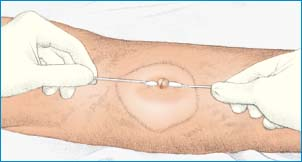Skin Staple and Clip Removal
Skin staples or clips may be used instead of standard sutures to close lacerations or surgical wounds. Because they can secure a wound more quickly than sutures, they may substitute for surface sutures where cosmetic results aren’t a prime consideration, such as in abdominal closure. When properly placed, staples and clips distribute tension evenly along the suture line with minimal tissue trauma and compression, promoting healing and minimizing scarring. Because staples and clips are made from surgical stainless steel, tissue reaction to them is minimal. Doctors typically remove skin staples and clips, but some facilities permit qualified nurses to perform this procedure.
Skin staples and clips are contraindicated when the wound’s location requires cosmetically superior results or when the incision site makes it impossible to maintain at least a 5-mm distance between the staple and the underlying bone, vessels, or internal organs.
Evacuating Fluid from A Sheet Graft
When small pockets of fluid (called blebs) accumulate beneath a sheet graft, you’ll need to evacuate the fluid using a sterile scalpel and cotton-tipped applicators. First, carefully perforate the center of the bleb with the scalpel.
 |
Gently express the fluid with the cotton-tipped applicators.
 |
Never express fluid by rolling the bleb to the edge of the graft. This disturbs healing in other areas.
Equipment
Waterproof trash bag ▪ adjustable light ▪ gloves (if needed) ▪ sterile gloves ▪ sterile gauze pads ▪ sterile staple or clip extractor ▪ antiseptic cleaning agent ▪ sterile cotton-tipped applicators ▪ Optional: butterfly or regular adhesive strips, compound benzoin tincture or other skin protectant.
Prepackaged, sterile, disposable staple or clip extractors are available.
Preparation of Equipment
Gather all equipment in the patient’s room. Check the expiration date on each sterile package and inspect for tears. Open the waterproof trash bag, and place it near the patient’s bed. Position the bag to avoid reaching across the sterile field or the wound when disposing of soiled articles. Form a cuff by turning down the top of the bag to provide a wide opening, thus preventing contamination of instruments or gloves by touching the bag’s edge.
Implementation
If your facility allows you to remove skin staples and clips, check the doctor’s order to confirm the exact timing and details for this procedure.
Confirm the patient’s identity using at least two patient identifiers according to your facility’s policy.1
Check for patient allergies, especially to adhesive tape and topical solutions or medications.
Explain the procedure to the patient. Tell him that he may feel a slight pulling or tickling sensation, but little discomfort, during staple removal. Reassure him that, because his incision is healing properly, removing the supporting staples or clips won’t weaken the incision line.
Provide privacy, and place the patient in a comfortable position that doesn’t place undue tension on the incision. Because some patients experience nausea or dizziness during the procedure, have the patient recline if possible. Adjust the light to shine directly on the incision.
If the patient’s wound has a dressing, put on gloves and carefully remove it.
Discard the dressing and the gloves in the waterproof trash bag.

Stay updated, free articles. Join our Telegram channel

Full access? Get Clinical Tree


Get Clinical Tree app for offline access
